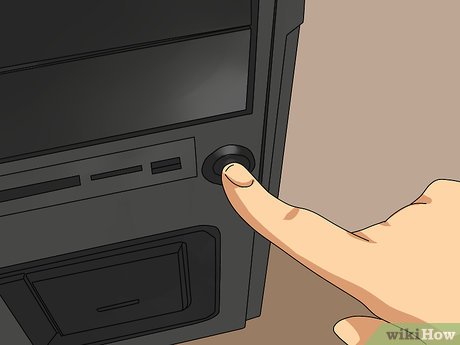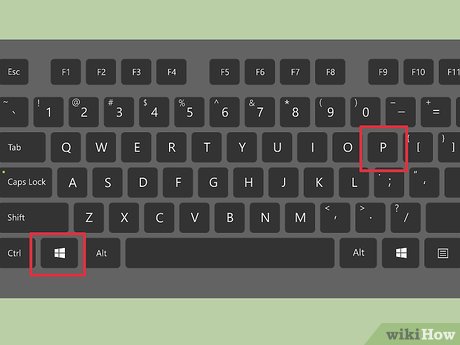How to Connect Two Monitors in Windows 7
Method 1 of 2:
Using a Hotkey
-
 Verify that both monitors are plugged in to your Windows 7 computer. Most Windows computers support VGA or DVI-I cables, but you may need to purchase an adapter if your computer lacks the necessary built-in port.[1]
Verify that both monitors are plugged in to your Windows 7 computer. Most Windows computers support VGA or DVI-I cables, but you may need to purchase an adapter if your computer lacks the necessary built-in port.[1] -
 Power on your computer.
Power on your computer. -
 Press the Windows logo key and the letter 'P' at the same time. A series of monitor options will display on-screen.
Press the Windows logo key and the letter 'P' at the same time. A series of monitor options will display on-screen. -
 Select one of the following options: 'Duplicate,' 'Extend,' or 'Projector only.' 'Duplicate' will display the same screen on both monitors, 'Extend' will allow you to navigate a full screen on both monitors, and 'Projector only' will show your screen only on the second monitor.[2]
Select one of the following options: 'Duplicate,' 'Extend,' or 'Projector only.' 'Duplicate' will display the same screen on both monitors, 'Extend' will allow you to navigate a full screen on both monitors, and 'Projector only' will show your screen only on the second monitor.[2]
Method 2 of 2:
Changing Screen Resolution Settings
-
 Verify that both monitors are plugged in to your Windows 7 computer. Most Windows computers support VGA or DVI-I cables, but you may need to purchase an adapter if your computer lacks the necessary built-in port.
Verify that both monitors are plugged in to your Windows 7 computer. Most Windows computers support VGA or DVI-I cables, but you may need to purchase an adapter if your computer lacks the necessary built-in port. -
 Power on your computer.
Power on your computer. -
 Right-click on your desktop and select 'Screen resolution.'
Right-click on your desktop and select 'Screen resolution.' -
 Click on the dropdown menu next to 'Multiple displays' in the Screen Resolution menu.
Click on the dropdown menu next to 'Multiple displays' in the Screen Resolution menu. -
 Select either 'Duplicate these displays' or 'Extend these displays.' The 'duplicate' option will display the same screen on both monitors, and the 'extend' option will allow you to navigate a full screen on both monitors.
Select either 'Duplicate these displays' or 'Extend these displays.' The 'duplicate' option will display the same screen on both monitors, and the 'extend' option will allow you to navigate a full screen on both monitors.- Select 'Show desktop only on 2' if you want to use only the second monitor for a presentation.
3.5 ★ | 2 Vote
You should read it
- How to fix the screen skew when using 2 monitors
- Two ways to pair the screen in Windows 7
- How to Use Two Monitors with Windows 8
- Common errors of LCD computer monitors
- Choose to buy an old CRT monitor
- How to Set Up Two Computer Monitors
- How to Set Up Dual Monitors
- How to set the resolution for many Windows 10 screens
May be interested
- How to Connect Two Monitors
 this wikihow teaches you how to connect a second monitor to your laptop or desktop computer. setting up a second monitor is possible on both windows and mac computers, but you'll need to make sure that your computer supports multiple...
this wikihow teaches you how to connect a second monitor to your laptop or desktop computer. setting up a second monitor is possible on both windows and mac computers, but you'll need to make sure that your computer supports multiple... - How to use 2 monitors on Windows 10
 how to use two monitors on windows 10. to mirror from a computer to two screens, we must prepare a cable connected to the monitor and the monitor must support standard connectivity on computers such as hdmi, vga ... if your computer has only one output port, vga or hdmi, you can buy and use video splitters such as dual vga, dual hdmi ...
how to use two monitors on windows 10. to mirror from a computer to two screens, we must prepare a cable connected to the monitor and the monitor must support standard connectivity on computers such as hdmi, vga ... if your computer has only one output port, vga or hdmi, you can buy and use video splitters such as dual vga, dual hdmi ... - How to install 2 monitors on a Mac computer
 setting up two monitors for use with a mac will be very convenient for those who have to do many tasks at the same time on the computer.
setting up two monitors for use with a mac will be very convenient for those who have to do many tasks at the same time on the computer. - Top 5 best gaming monitors 2020
 top 5 best gaming monitors for gamers can not be ignored with many reasonable prices. you can consult to choose to buy products that suit your needs.
top 5 best gaming monitors for gamers can not be ignored with many reasonable prices. you can consult to choose to buy products that suit your needs. - How to use multiple computer monitors at the same time effectively
 arranging, using software, adjusting the mouse ... are methods to help increase the multi-screen experience for computer users.
arranging, using software, adjusting the mouse ... are methods to help increase the multi-screen experience for computer users. - How to Connect a Gaming Console to a Computer Monitor
 if you want to play your console games but don't have a tv, you can use a computer monitor instead. computer monitors are often cheaper than tvs, and many people have old monitors lying around in storage that can be put to good use playing...
if you want to play your console games but don't have a tv, you can use a computer monitor instead. computer monitors are often cheaper than tvs, and many people have old monitors lying around in storage that can be put to good use playing... - How to change monitors 1 and 2 in Windows
 in windows 10 and 11, you can rearrange multiple displays connected to your computer to reflect their physical arrangement. similarly, you can also configure any display as your primary display.
in windows 10 and 11, you can rearrange multiple displays connected to your computer to reflect their physical arrangement. similarly, you can also configure any display as your primary display. - How to install Miracast Connect app on Windows 10
 previously, the connect app was pre-installed by default, but starting with windows 10 version 2004, it is an optional feature that you have to manually install to connect to compatible devices. miracast.
previously, the connect app was pre-installed by default, but starting with windows 10 version 2004, it is an optional feature that you have to manually install to connect to compatible devices. miracast. - Instructions for activating and customizing virtual Touchpad on Windows 10
 the virtual touchpad is used as a physical touchpad (regular touchpad) on the windows operating system, and supports all the features available as physical touchpad. it can be said that virtual touchpad is a useful feature in some cases when users connect to external monitors (external monitors). with the virtual touchpad feature built into the operating system, users can easily activate and use the virtual touchpad on windows 10 without having to install any 3rd party software or applications.
the virtual touchpad is used as a physical touchpad (regular touchpad) on the windows operating system, and supports all the features available as physical touchpad. it can be said that virtual touchpad is a useful feature in some cases when users connect to external monitors (external monitors). with the virtual touchpad feature built into the operating system, users can easily activate and use the virtual touchpad on windows 10 without having to install any 3rd party software or applications. - How to set up different wallpaper images on each Windows 10/11 screen
 setting up multiple monitors on windows is quite simple and only takes a few minutes to do. once you have set up multi-monitor mode (multiple monitors), you can set up individual wallpapers for each monitor. to do this, please refer to the article below from network administrator.
setting up multiple monitors on windows is quite simple and only takes a few minutes to do. once you have set up multi-monitor mode (multiple monitors), you can set up individual wallpapers for each monitor. to do this, please refer to the article below from network administrator.












 How to Enable Cookies in Windows 7
How to Enable Cookies in Windows 7 How to Revert to the Classic Taskbar on Windows 7
How to Revert to the Classic Taskbar on Windows 7 How to Install Themes for Windows 7
How to Install Themes for Windows 7 How to Access Shared Folders in Windows 7
How to Access Shared Folders in Windows 7 How to Optimize Windows 7
How to Optimize Windows 7 How to Install the Windows 7 OS on a Portable Hard Drive
How to Install the Windows 7 OS on a Portable Hard Drive